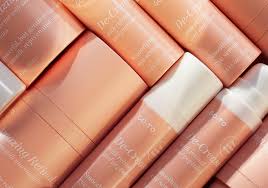What’s the damn difference between Very Amazing Retinal and De-Crease?
Our Retinal family is growing. And fast. Because we want to give you more.
More complex formulas, more potent products, more results.
You know De-Crease, but it’s time to pass on the Spirit Stick to Very Amazing Retinal. A horribly “amazing” (our legal team squirm when I use that word, so shhh) all-over face vitamin A serum.
One that smooths and nourishes the skin on your forehead, cheeks, marionette lines, and neck.
Reduce. Very Amazing Retinal.
Tom-a-to. Tom-ah-to. Uh? Not exactly.
In fact, there’s a pretty big difference between the two.
Let me break it down. But first, the launch of Very Amazing Retinal doesn’t mean you have to sever your ties with De-Crease. For any Retinal newbies (and there are many of you), De-Crease is a really great place to start testing powerful ingredients and seeing how your skin reacts. Before using Retinal on your entire face.
What is the difference between Very Amazing Retina and De-Crease?
Strength
Very Amazing Retinal is a stronger Retinal than De-Crease (because this eye serum is designed to treat highly sensitive skin areas). The Encapsulated Retinal is 0.25%. This is 2.5 times stronger than De-Crease because it has to work on a larger, thicker area of skin.
Remember: Strength isn’t everything. The entire formula and the type of retinoid used (derivatives/esters/blends aren’t as “pure” as Retinal) can affect a product’s performance.
Formula
The peptides (a powerful anti-aging ingredient) in each product have been clinically proven to be effective in treating specific areas of the face. While Tetrapeptide-1 in De-Crease has been tested to improve fine lines and wrinkles only around the eye area, Hexapeptide-8 in Very Amazing Retinal has been tested to improve skin tone, texture, and pigmentation in other areas of the face.
In Very Amazing Retinal, you’ll also find asiaticoside, madecassic acid, and asiatic acid (the powerful soothing component of Centella asiatica) to further protect the skin. Give it a higher concentration of Vitamin A.
Other than that, the hydrating, brightening, and soothing ingredients supporting these heavyweights remain the same in both formulas. We’re talking about glycerin, niacinamide, vitamin C, mushroom extract.
Can I use Very Amazing Retinal and De-Crease at the same time?
No, please don’t. Layering two retinal serums together may cause irritation. The skin can’t handle so many high-potency active ingredients in the same routine.
If you feel you need or want both – i.e. your eye area is more sensitive than the rest of your face, or your eye area may age faster than the rest of your face, so a serum proven to treat that area is a better choice – don’t worry. Just make sure to alternate between using Very Amazing Retinal and De-Crease every other night. Never together.
Can I use Very Amazing Retinal under and around my eyes?
If and only if your eye area can handle the strength and formula of Very Amazing Retinal.
The skin around your eyes is thinner and more delicate than the rest of your face. It is not compatible with really active serums or really rich creams. Therefore, if such products are used repeatedly, it may cause skin discomfort. This may manifest itself in the form of redness and irritation – which can lead to contact dermatitis. We don’t want that. No sir.
Can I use De-Crease all over my face?
The short answer is technically yes. The long answer is: why would you want to? As mentioned above, De-Crease is designed to target the delicate eye area.
The rest of your face will benefit from a product designed specifically for the rest of your face, all the way down to your breasts. (It’s time you got introduced to the Very Amazing Retinal.)
Eye serums are also usually a bit more expensive and come in smaller jars or cans, so it’s a bit of a waste to apply this product to your face. And it’s much more expensive than simply choosing a facial product.
Can you see? Same. Even. But different.
Very Amazing Retinal and De-Crease have a place in every serious skincare user’s routine.
DQH Can I use salicylic acid first and then vitamin C?
It’s easy to create a skincare routine, but knowing how to use it is another thing entirely. In most cases, if you’re not getting the desired skin results, it could be due to the layering of conflicting ingredients. So, is it possible that salicylic acid and vitamin C are such ingredients? Or are these active ingredients the duo that’s been missing from your skincare routine? If you want answers, stick around because today we are going to explain the benefits of salicylic acid and vitamin C and how they can be used in your daily life.
What are the benefits of salicylic acid for skin?
Salicylic acid is one of the most commonly used beta hydroxy acids and is favored by many people with oily, acne-prone skin. This acid is derived from willow bark, and unlike its water-soluble relatives (called alpha-hydroxy acids), salicylic acid is oil-soluble, which means it can penetrate deeper into the lower layers of the skin. Once it reaches the lower layers, it can help unclog pores of excess sebum, dirt, bacteria, debris, and impurities. This results in clearer skin tones and greater definition.
Not only does salicylic acid benefit the underlying layers, but the outer surface of the skin benefits as well. When applied to the skin, salicylic acid removes the buildup of dead skin cells. This is accomplished by breaking the bonds that hold dead cells to the surface. Over time, this can cause the complexion to look dull and prone to acne, blackheads, and other blemishes.
If you’d like to learn more about salicylic acid and how it can improve your skin, check out this dedicated blog post from a beauty insider.
What are the benefits of vitamin C for skin?
Vitamin C is considered one of the most powerful antioxidants, which means it is very effective at fighting free radicals and preventing them from causing further skin damage. Examples of free radicals include pollution, central heating, UV rays and harsh climate. They attack proteins, fats and cell membranes as soon as they come into contact with the skin, causing signs of premature aging such as fine lines and wrinkles as well as hyperpigmentation, flaky patches of skin and loss of elasticity.
Many people usually prefer to use vitamin C in their morning routine as this ingredient gives the complexion a radiant glow. You’ll also find that vitamin C can target areas of hyperpigmentation, plumping the skin and reducing the appearance of fine lines and wrinkles.
The thing about vitamin C is that there are a lot of outdated studies going back to the 1950s that describe vitamin C as an unstable skin component. Thanks to improvements in modern technology, this is no longer the case as all products now contain a stable form of vitamin C.
Visit The Beauty Insider to learn more about vitamin C. So please check out our blog post.
Can I use salicylic acid first and then vitamin C?
Yes, you absolutely can. In fact, it’s thought that using salicylic acid before using vitamin C ensures it penetrates faster and works faster.
This is an efficient way to utilize two power sources, and the reason has to do with pH. For example, the skin’s natural pH is about 4.7, making it slightly acidic. Salicylic acid and vitamin C are also both acidic, and you’ll find that vitamin C is absorbed quickly into the skin. Therefore, using salicylic acid beforehand can increase the acidity of the skin and allow vitamin C to penetrate into the skin faster.
While this is considered an effective way to combine two powerful ingredients, you need to be aware of your skin type and how it reacts to certain active ingredients. Even people with perfect, normal skin can experience skin sensitivity and irritation. Therefore, always consult a doctor or dermatologist before using any new products on your skin.
It’s also important to follow skin application rules. In this case, you need to use the product correctly to ensure you get the best results for your skin. If you’re not sure what I mean, the basic rule for skin is to start with the thinnest consistency and work your way up to the thickest consistency. This prevents a barrier from forming on the surface, preventing other active ingredients from penetrating the skin.
Can I use salicylic acid at night and vitamin C in the morning?
Yes, absolutely, this is considered the most effective way to get returns without any adverse side effects. This is because there is enough time between applications to ensure that the skin’s pH levels return to balance.
You’ll also find that Vitamin C is rich in antioxidants and is perfect for use in the morning to ensure your skin is protected and looking its healthiest. Due to the small size of salicylic acid molecules, it is an acid that is able to reach the deepest parts of the skin. While this is effective at keeping skin clear, it also increases the risk of irritation and photosensitivity. Therefore, many people prefer to use powerful BHAs in their evening routine without exposure to UV rays, pollution, or harsh weather.
Warning: If you avoid using sunscreen every day, none of these ingredients will do what your skin needs. The combination of chemical peels and powerful ingredients increases the risk of further damage to the skin’s surface. Use SPF 50 every day to keep your skin protected and your lipid barrier healthy, even on cloudy days, keeping your skin in top condition.



